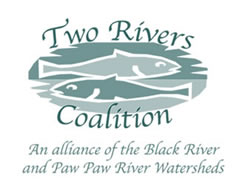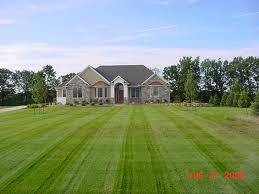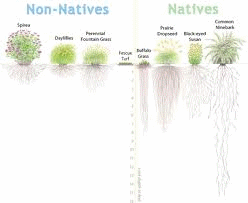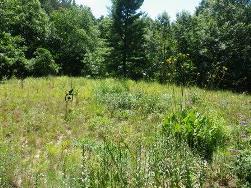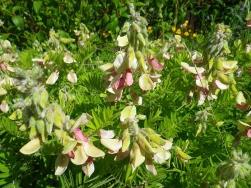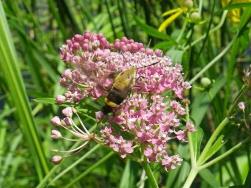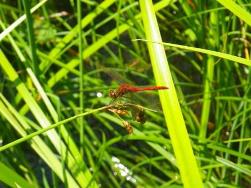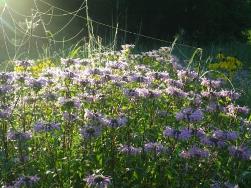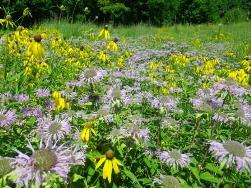Home>Let It Flow
Lawn Rant...Or Where I Go Out of My Way to Offend Almost Everyone
After my last blog on fracking, my editorial board called me in for a meeting. “Kevin, we are concerned that your blog is too mild-mannered, too milk-toast. We need you to elevate the rhetoric and be more controversial in order to drive up the readership numbers. ” Well, I can take a hint. Obviously, the solution is simply to offend a larger percentage of my readers. As I drove around Van Buren County [in my environmentally friendly hybrid] I was thinking: “What shibboleths do my readers hold most dear? True love? One man one vote? The existence of God?” Then, as I drove past endless plots of rectangular green grass, it hit me. What Americans cherish most is their obsession with their lawns. Now I had a target in my sights. Hold on Gentle Reader, it is going to be a wild ride…
Although I am going to concentrate on the environmental absurdity of lawns, that is not to say there aren’t other legitimate grounds to condemn them. For instance, aesthetics. Lawns are ugly and boring. Monochromatic green rectangles, one after another after another. Usually the only variation you see is the number of yellow dandelions temporarily flourishing between chemical treatments. Despite the existence of thousands of species of plants that could grow in a temperate climate, we choose to plant only one [usually some cultivar of Kentucky Bluegrass]. Imagine if Rembrandt himself came up to your door and offered to paint a landscape scene for you to hang on your living room wall. Would you say, “Thanks, I would like a nice blank white canvas hanging right here above my sofa, just like my neighbor.”? Well, that is what a green square of Kentucky Bluegrass looks like in front of your house. It constantly amazes me that people will not hesitate to pay a quarter of a million dollars for a house in a subdivision even though every single house there has the exact same green rectangle in front. Frankly, I don’t think people necessarily like the boring sameness of their lawns. I think it is more likely they never even stop to wonder if a lawn has any redeeming aesthetic value. We simply take it for granted without any conscious thought [after all, everyone else in the subdivision is doing it, so it has to be all right, doesn’t it?]
Did you know a desert could be a deep shade of green? Yep, that is what is growing in front of your house, a desert. Nothing but a monoculture of lawn grass that supports virtually no life. There is more biomass [not to mention biodiversity] in a square meter of Sonoran desert than in your lawn. That is partly because typical lawn grass has a shallow root system that is only a few inches deep. Not much of a habitat for any living thing. Also, lawn is completely ineffective at managing rain water. Although it might seem as if your lawn is constantly sucking up water while you are standing there with your hose on a scorching August afternoon, the shallow root system of lawn grass means it cannot absorb and retain large amounts of water. So when there is a heavy rain, your lawn is quickly saturated and most of the rain runs off immediately. Where does that excess water go? Onto your driveway, then down to the road, then to a ditch connected to a storm sewer and finally into your local river, thereby contributing mightily to the pollution of our waterways. Ah hah! [You were wondering how I was going to tie this into water quality on the Paw Paw and Black Rivers.]
But is the poor water retention the only environmental drawback of our lawn obsession? Absolutely not. There is a frighteningly large carbon footprint to that boring and lifeless patch of green in front of your house. Remember, the only thing Kentucky Bluegrass does well is absorb sunlight and translate that energy into rapid upward growth of its stalk. Since lawn grass seems to lose its aesthetic appeal for most people when it gets more than an inch or two high, there is an endless cycle of grass mowing going on throughout the growing season. How much gas do we use to cut our lawns? According to the University of Vermont, as a nation we use 2.2 billion gallons of fuel every year on lawn care. It turns out that the carbon footprint of our lawns is not just the mowing. It takes lots of fuel to process the fertilizer we apply every spring, as well as run the string-trimmers, leaf blowers, edgers, etc. Americans use to manicure their lawns. And these small engines are dirty: one hour of mowing produces the same amount of smog- forming hydrocarbons as driving a car between 100 and 200 miles. It is estimated that the 20,000,000 small engines sold in the U.S. every year contribute one tenth of the total U.S. mobile emissions and are the largest single source of non-road emissions.
Then there are the chemicals and fertilizers. This Spring as I drove around the suburbs of greater Chicago making plant deliveries for my friends’ small business, I was surprised at the number of trucks such as TrueGreen, Chemlawn, etc. Apparently it is big business convincing suburbanites that their lawn won’t flourish without the right chemical additives. It doesn’t take a rocket scientist to understand where all that fertilizer ends up as soon as there is a heavy rain. It washes into the storm sewers, then into the rivers and eventually [for the western Chicago suburbs] into the Gulf of Mexico where it supplies the nutrients for algae blooms that rob the ocean of oxygen and cause extensive dead zones. Now come on, is your desire for a lush looking green lawn really worth contributing to the death of our oceans and Great Lakes?
Is there an alternative? Of course! I haven’t mowed my yard in 17 years. I also haven’t watered it or added any fertilizer. You too can [and should] grow native plants in your yard instead of Kentucky Bluegrass. Native bunch grasses and prairie flowers have deep root systems that are much better at absorbing and retaining excess water from heavy rain events. Once established, their deep tap roots allow native plants to rely just on rainfall and not require supplemental watering to survive. Contrast that with your traditional Kentucky Bluegrass lawn that starts to turn brown in even a minor drought. A prairie planting of bunch grasses [Big Bluestem, Little Bluestem, Indiangrass, etc.] never requires mowing but will benefit from either burning or mowing once every year or two in the late Fall or early Spring to return nutrients to the soil and prevent tree seedlings from coming up. Native plants don’t need fertilizer or chemical treatments because they evolved here and fit into the ecosystem without the help of the petrochemical industry. And a well established prairie does not even need significant weeding. All told, I probably spend a couple hours throughout the entire summer pulling potentially invasive weeds [like Spotted Knapweed] or yanking out small tree seedlings from my multiple prairie plots.
Aesthetically, the variety of colors and shapes in even a small prairie planting is wondrous to behold. I am not just talking about the varied palette of the 30 plus wildflower species that begins with the blooming of the Lupine in early May and finally culminates with New England Aster in October. The bunch grasses themselves provide color, form and texture throughout the year. I have spent many a dreary February day gazing out the window at the reddish brown hummocks of the bunch grasses superimposed on the backdrop of white snow. Sometimes I watch winter birds eating the seeds of the grasses or taking cover in the hummocks and I think how boring and mundane the vista would be if it was simply a flat, white, and lifeless rectangle of snow covered lawn.
But most importantly, there are also positive benefits to your local wildlife by switching from a traditional lawn to native grasses, flowers and shrubs. The woodland, grassland, and wetland ecosystems which were present in Michigan at the time of first European settlement two hundred years ago have virtually disappeared. We can’t even begin to understand the intricate connections that existed between various insect, animal, and plant species [and probably never will for those species now extinct]. We do know that while some insect pollinators are generalists and can pollinate multiple different plant species, other are very species specific. This means some types of plants rely on a single insect species for pollination. If that insect species declines in numbers or goes extinct, the plant species will also decline or die out entirely. An extreme example is the Brighamia plant [a succulent] that grows high on sea cliffs in Hawaii. Each year it must be hand-pollinated by rock climbers suspended from ropes because its insect pollinator has become extinct. Insects are also essential to birds. Ninety percent of all bird species eat insects at some time in their life cycle; fewer insects mean fewer birds. Growing a wide variety of native plants contributes to biodiversity by providing food and habitat for the insect species that our native plants and birds [and Homo sapiens] ultimately depend on.
Then there are the butterflies. Everyone knows butterflies need nectar and get it from flower blossoms. But most butterflies also require a specific host plant on which to lay their eggs. The most famous example is the Monarch butterfly which feeds on multiple different flowering plants but which will only lay its eggs on plants in the Milkweed family. In researching for this blog, I also learned that the Zebra Swallowtail butterfly uses the Paw Paw tree [which grows abundantly in my woods] for its larval host. By growing native plants which are good for insects [nectar or host for larvae] we can help make up for the loss of habitat as more and more woods, wetlands, and savannas get developed into big box stores [so you can buy more things that you don’t really need].
I can already hear you whining: “Where will the kids play if I turn part of my 5 acres of lawn into native plants and grasses?” Frankly, your kids or grandkids probably don’t run around your yard anyway. They are too lazy to get exercise playing kickball or tag or the kinds of games we played as kids. They simply stay inside playing high tech games on huge flat screens. If you did have the gumption to send them outside to play, the little brats would just whip out their smart phones and still refuse to run around your ridiculous looking desert of Kentucky Bluegrass. But maybe, just maybe, if you sent them outside and they saw lots of different kinds of butterflies, sphinx moths, and hummingbirds going crazy over your smorgasbord of native plants, your kids might actually be interested and engaged in Nature [and start to want to go outside]. But if you absolutely love lawn and hate Nature, there is still something you can do to lessen your carbon guilt. Switch from fast growing Bluegrass to a slow growing mix of fescue grasses. My wife insisted on having a little buffer of “civilization” between our house and the woods, prairie, and pond. She started a small yard by spreading a mix of fescue grasses [called “No Mow Grass”] which she cuts about twice a summer using an electric string trimmer. No one would ever confuse this lawn with a putting green but it functions just like a Bluegrass lawn without requiring constant mowing and watering.
OK, this is the part where I get angry and even more offensive. If you think of yourself as an environmentalist, there is no excuse for continuing to mow large lawns. The modest cost of switching to native wildflowers, grasses and shrubs will be quickly offset by the savings on lawn mowing, fertilizing, etc. And you can start small if you are feeling a little trepidation. Choose an out-of-the way corner of your back yard, analyze your soil type, moisture and sunlight conditions and convert it. See the resource list below for help. Plant a variety of bunch grasses and wildflowers that will bloom throughout the growing season. Include a small tree [Redbud, Flowering Dogwood] or native shrub [Spicebush] or two. Be patient and give it a year or two to get established. And when there is an explosion of beauty and birds and butterflies in your back yard, you can make your tiny patch of Nature a little bigger each year…and maybe even creep into your front yard as well! Come on, what do you have to lose …besides your region’s biodiversity and your self-respect?
Resources:
Wild Ones Native Plant Landscapers. Information on Kalamazoo area chapter at: www.kalamazoowildones.org
Noah’s Garden. Book by Sara Stein.
Planting Noah’s Garden. Book by Sara Stein.
Bringing Nature Home. Book by Douglass W. Tallamy.
Hidden Savanna Nursery. Local [Oshtemo] grower of native plants: www.hiddensavanna.com
Native Connections. Local [Three Rivers] producer of seed mixes: www.nativeconnections.net
Michigan Native Plant Producers Association. Information on Michigan native plant growers at: www.mnppa.org/members
Bravo! One of America's strange nonsensical obsessions the lawn, but a little no-mow fescue is nice for backyard picnics. Has TRC looked at negotiating property maintenance requirements at the local level? Most local codes restrict the height of lawn and grass to under 6-8 inches to avoid so-called "weedy" appearance. I found that the covenants and codes of my own neighborhood are even more restrictive and sadly we have a bunch of retired people that call themselves neighborhood volunteers and spend all their time measuring peoples yards and sending them citations.
Also, native plant maintenance. Due to the excessive amount of non-native/invasive plant seed used by the Road Commission and sold at regional nurseries, these invaders can make it difficult to maintain native patches. Anything TRC could do to make these practices illegal will go a long way toward making these objectives even easier to accomplish. Thanks, great rant
Thanks, Kevin, for another great post. I think you're working on a book's worth of these!
And you're right: my lawn does suck. I mow it every three weeks and have never, in 19 years watered or applied fertilizer. So it looks like what G. Cripe wants his lawn to look like if only the old guys with their grass-check yardsticks would quit turning him into the Turf Police.
The trick, I believe, would be to get some Lawn Ranger (of the sort pictured in your post) to plant half or even a third of their lawn in prairie. Focus on purple coneflowers, black eyed susans and butterfly weed -- something colorful. Then, host a dinner party (McMansions are made for those) and show off the new "butterfly garden." Let people see that this is something legitimate, a feasible and socially acceptable option to their ChemLawn addiction. Have a wild landscaper on hand to share samples and site plans. Maybe this type of upscale peer group pressure could start to turn things around.
Another great post, Kevin! I've started, but this is going to be my next great project and now I know that you are an experienced info resource. Thanks again for all that you do!
